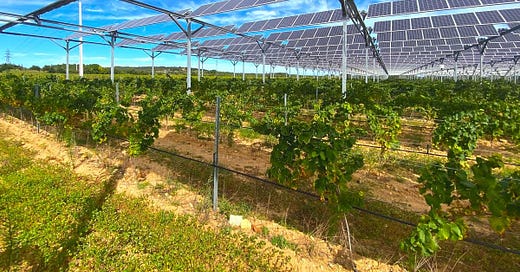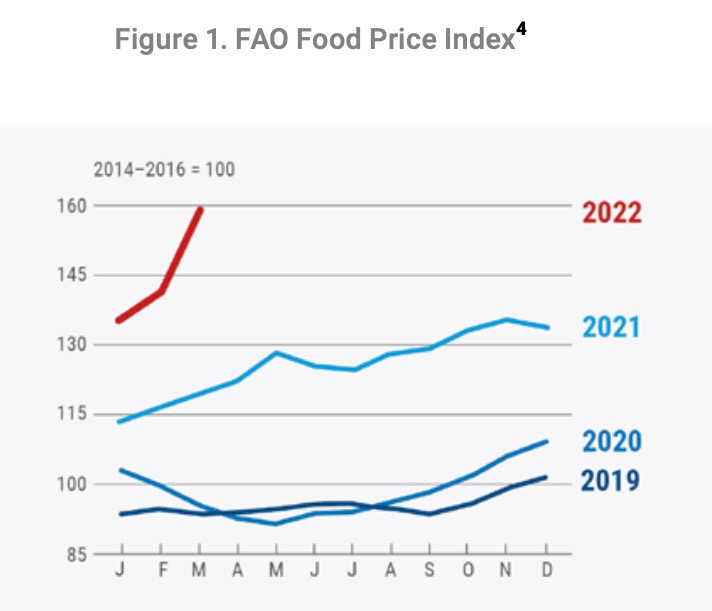Welcome to the web version of Need to Know: Science & Insight, my personal newsletter that looks at what we Need-to-Know at this time of pandemic, existential crisis of climate change and unravelling of nature’s life supports.Food prices are 34% higher than a year ago.
They are at the highest since the U.N. Food and Agriculture Organization started recording them in 1990. In fact, the prices in its Food Prices Index—a measure of the most commonly traded food commodities— are literally off the chart.
As many as 1.7 billion people in 107 countries face large-scale crisis from record-high food and energy prices and growing levels of debt. These countries, mostly in Africa, Asia and the Pacific, and Latin America and the Caribbean, had already been struggling with impacts of the pandemic crisis and climate change.
Exposure to just one additional risk is enough to cause debt distress, food shortages or blackouts, according to a preliminary analysis by the United Nations’ Global Crisis Response Group.
“All of this is hitting the poorest the hardest and planting the seeds for political instability and unrest around the globe.”
—UN Secretary-General António Guterres:
Grim stuff in what will be a challenging year ahead. Here’s some context. Of the world’s cereal crop production (rice, wheat, corn, etc) :
48% is eaten by humans
41% is used for animal feed
11% for biofuels (ethanol, biodiesel)
Of all the wheat, rice, corn, rye, oats, barley, sorghum grown in the US every year a mere 10% is eaten by people. The rest is for animal feed and biofuels.
Need-to-Know 1: 90% of crops grown in the US are used for animal feed or biofuels.
(It is roughly the same proportion (+/-10%) in Canada, Australia, and most of Europe.)
The US converted 121 million tons of its corn crop into ethanol in 2019. Although considered a “green fuel”, ethanol’s lifecycle carbon emissions are no better than gasoline. Some studies say it is worse.
Globally, some 70 million acres of food-producing land is devoted to biofuels that provide less than 5% of the world’s transportation fuels.
Need-to-Know 2: 70 million acres of farmland is used for biofuels.
Need-to-Know 3: Plants make shitty solar panels
Plants convert approximately 0.023% of the sunlight energy they receive. A solar panel with 20% efficiency converts 20% of the sunshine it receives into electricity. The best solar panels on the market today can reach almost 25% efficiency.
I did a real-world energy comparison between plants and solar panels — and had it vetted by experts.
An acre of high-yield corn in the US midwest can be converted into 500 gallons of ethanol on average. If a vehicle could run on 100% ethanol, it would travel 8,750 miles on 500 gallons. (Ethanol has 30% less energy than gasoline.)
An acre of solar panels produces an average 350 megawatt hours (MWh) in one year. That’s enough electricity to be able to drive a Tesla Model 3 some 1,400,000 miles. (Model 3 uses 62 KWh to travel 250 miles.)
That is 160X more miles from solar on the same acre of land in this tank-to-wheels comparison. Among the reasons the Tesla could go 160X further is the 400% better energy efficiency of electric vehicles compared to gasoline or diesel-powered vehicles.
In other words, to match the annual travel distance of EVs recharged from 1 acre of solar, requires 160 acres of corn converted into ethanol. (Even accounting for losses from electricity transmission, battery charging and grid storage.)
Iowa uses 8 million acres to grow corn for ethanol. If Iowa put solar panels on just 50,000 acres that would generate the same amount of vehicle fuel as the 8 million acres of corn-ethanol. Plus no emissions. No fertilizers. No need to plant, water and fertilize a crop every year.
BONUS: Iowa would have 7.95 million more acres to grow food people can eat.
Food crisis solved.
Of course there’s more to the food crisis than reclaiming land from ethanol and other types of biofuel production but converting some of those acres to food production is a big part of solving the problem.
Besides sunlight-to-energy conversion of 0.023% vs 20%?
Who the hell ever thought ethanol and biofuels was a good idea?
Until next time, stay safe.
Stephen
P.S. Farming solar panels.
Solar panels elevated two to four metres (6 to 12 feet) above farm fields help food crops grow with less water. The plants can help panels produce up to 10% more energy because the panels stay cooler, according to studies.
This is called agrivoltaics. Farm workers and tractors can also work underneath the panels. (See picture at top)





